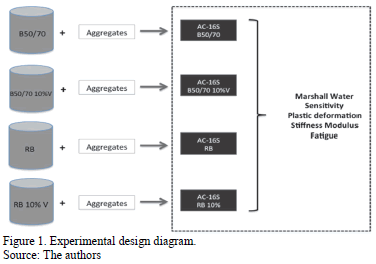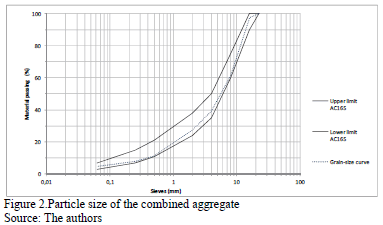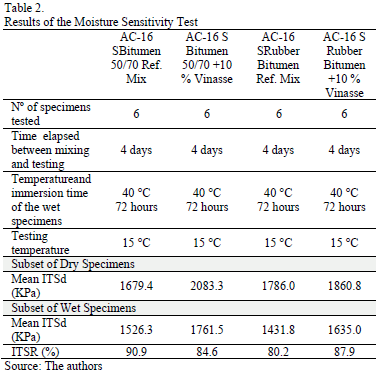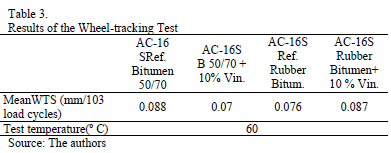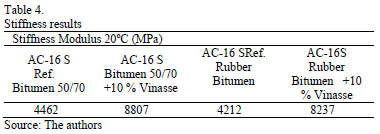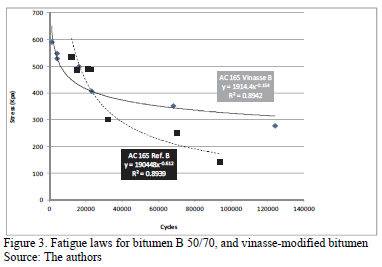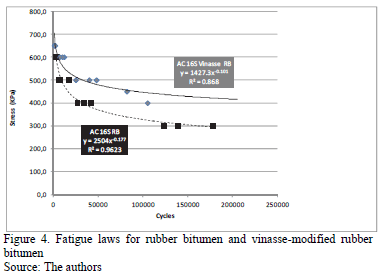Services on Demand
Journal
Article
Indicators
-
 Cited by SciELO
Cited by SciELO -
 Access statistics
Access statistics
Related links
-
 Cited by Google
Cited by Google -
 Similars in
SciELO
Similars in
SciELO -
 Similars in Google
Similars in Google
Share
DYNA
Print version ISSN 0012-7353
Dyna rev.fac.nac.minas vol.82 no.194 Medellín Nov./Dec. 2015
https://doi.org/10.15446/dyna.v82n194.44432
DOI: http://dx.doi.org/10.15446/dyna.v82n194.44432
Valorization of vinasse as binder modifier in asphalt mixtures
Revalorización de la vinaza como modificador de betún para mezclas bituminosas
Mª José Martínez-Echevarría-Romero a, Gema García-Travé a, Mª Carmen Rubio-Gámez a, Fernando Moreno-Navarro a & Domingo Pérez-Mira b
a Laboratorio de Ingeniería de la Construcción, Universidad de Granada, Granada, España,. mjmartinez@ugr.es, labic@ugr.es, mcrubio@ugr.es, fmoreno@ugr.es
b Departamento I+D+i, Construcciones AZVI, Sevilla, España. dperez@construccionesazvi.es
Received: July 15th, 2014. Received in revised form: July 29th, 2015. Accepted: October 22th, 2015.
This work is licensed under a Creative Commons Attribution-NonCommercial-NoDerivatives 4.0 International License.
Abstract
The reutilization of waste generated by industrial processes has become a majorenvironmental objective in scientific and technical research. In the construction sector, there is a broad range of techniques for the exploitation of different types of waste, which can then be used as a replacement for raw materials. This paper presents the results of a study of vinasse, a by-product of biomass ethanol, andanalyzes its viability as a bitumen modifier in asphalt mixes. For this purpose, four AC-16S asphalt mixes were evaluated for moisture sensitivity, plastic deformation, stiffness, and fatigue. The mix formulas were the following: (Mix 1) 50/70 bitumen; (Mix 2) 50/70 bitumen modified with 10% vinasse; (Mix 3) rubber bitumen; (Mix 4) rubber bitumen modified with 10% vinasse. The results of this study showed that bitumen modified with vinasse improved the mechanical performance of the AC-16S mix and also contributed to the valorization of vinasse waste.
Keywords: Asphalt mixture, binder modifier, mechanical behavior, vinasse.
Resumen
La reutilización de los residuos derivados de los procesos industriales se ha convertido en uno de los objetivos prioritarios de carácter ambiental en la investigación científica y técnica. En el sector de la construcción, se pueden aprovechar materiales residuales de otros procesos en sustitución de materias primas. Este artículo presenta los resultados de un estudio desarrollado con el objetivo de valorizar la vinaza residual del proceso de fabricación de etanol a partir de biomasa, como material modificante del betún utilizado en las mezclas bituminosas. Se han fabricado cuatro mezclas bituminosas tipo AC-16S (1: Betún 50/70, 2: Betún 50/70 + 10%vinaza, 3: Betún-caucho, 4: Betún-caucho + 10%vinaza) y se han realizado ensayos de caracterización como son sensibilidad al agua, resistencia a las deformaciones plásticas, rigidez y fatiga.Los resultados muestran que las mezclas modificadas con vinaza mejoran el comportamiento mecánico de la mezcla AC-16 S y contribuye a la revalorización del residuo.
Palabras clave: Mezcla bituminosa, betún modificado, comportamiento mecánico, vinaza
1. Introduction
Vinasse is a by-product that remains in the distillation column when ethanol is produced from biomass. It is the main waste material generated in alcohol distilleries and its release without previous treatment has an extremely negative impact on the environment. The composition of vinasse can vary depending on the nature of the distillation process. However, vinasse typically has a low pH (3-5) and a high content of organic matter (35,000-50,000 mg O2/L BOD),which makes it a toxic substance[1].
The uncontrolled discharge of vinasse into the soil can negatively affect soil quality by increasing thesalinity of the soil, thusdeteriorating its structure, porosity, and fertility[2]. Furthermore, since the production temperature ofvinasse is 50-80ºC, its release into aquatic environments without previous cooling can increase water temperature and lower the oxygen content to a level at which fish cannot survive[3,4]. In addition, the turbidity and color of vinasse can trigger processes of photosynthesis that also endanger aquatic life forms [5].
Currently, more and more countries are enacting stricter laws that regulate the discharge of waste from alcohol distilleries. For example, in 2005, the Indian government decided to rapidly transform distillation industries into zero-discharge industries [6]. Europe is also implementing similar measures to achieve the same objective by processing waste in waste treatment plants as well as by reusing and recycling it[7].
The anaerobic digestion of vinasse is an interesting way to reduce vinasse waste, because, in addition to promoting the stabilization of organic matter, it also enables energy generation from biogas, as Bruna S. Moraes reflects in her study[8].
Another way to reuse waste is by incorporating it into bituminous mixes. A wide range of studies have analyzed how the characteristics of these mixes can be enhanced with the addition of recycled waste material or by using this waste instead of one of the mix ingredients. This is an excellent way of reducing waste deposits and discharges. It is also more cost-effective since there is less need to use raw materials. Glass, steelworks slag, plastic, and rubber are examples of different types of waste material that have been used in asphalt mixes[9]. However, in recent years, the main focus has been on rubber from end-of-life tires and polymers [10-14].
In this study, vinasse was the waste used to manufacture bituminous mixes. The objective was to study the mechanical performance of these mixes when vinasse binder was added to modify the bitumen. For this purpose, we analyzed an AC 16 S bituminous mix, manufactured with 50/70 bitumen modified with 10% vinasse,as well as a rubber bitumen mix also modified with 10% vinasse. The performance of thevinassemixes was compared to that of the same mixes manufactured with unmodified bitumen and rubber bitumen.
2. Material and methods
For this study the asphalt mix used wasan AC-16S mix, which is commonly used in wearing courses in countries throughout the world. It is a dense asphalt concrete mix with an air voids percentage of 4-6%, a continuous coarse grain size (maximum particle size of 22 mm) and a bitumen content of 3.5-5% of the total mix weight. The mix is usually spread in layers of 5-8 centimetres.
Before beginning the battery of laboratory tests, four AC-16 S mixes were manufactured. The first two were regarded as the reference mixes. The first mix was manufactured with conventional penetration grade bitumen B 50/70 and the second with rubber bitumen. The third and fourth mixes were also manufactured with the same types of bitumen as the first two, but they were modified with biopolymers obtained from vinasse. In other words, the third mix was made from penetration grade bitumen B 50/70 modified with 10% vinasse and the fourth mix was made from rubber bitumen, also modified with 10% vinasse.
The bitumen was supplied by the University of Huelva in southern Spain where it was characterized and modified with the previously mentioned percentage of vinasse. The laboratory tests in this research study start with the design of the asphalt mixes by determining the optimal bitumen content for four mixes with the same mineral skeleton. This bitumen content was ascertained with the Marshall Test, as described in the Spanish Standard NLT 159/00 and in article 542 (guidelines for hot bituminous mixes) of the General Technical Specifications for Road and Bridge Works (PG3).
As previously mentioned, the substance used to modify the bitumen was vinasse, the liquid waste remaining after alcohol distillation. The phase separation of vinasse effluent (pH =4.58) is characterized by a precipitate with a higher concentration at the bottom and a supernatant with suspended solids on the surface. Before being mixed with the bitumen, the vinasse was first dehydrated at 70º in a convection oven. Its grain size was reduced with a laboratory blade mill (IKA, Werke model) as well as a sieve with a mesh size of 3.0 mm. The final product was then added to the bitumen in a proportion of 10%.
Ophite was used as an aggregate in the mix for the coarse fraction, and limestone was used for the fine fraction. The filler was CEM II /B-L 32,5 N cement. The materials in the mixes were first characterized as specified in article 542 (guidelines for hot bituminous mixes) of the General Technical Specifications for Road and Bridge Works (PG3).
The same set of tests was then applied to all four mixes in order to study their mechanical performance and to compare the mixes with modified bitumen withthe mixes made of unmodified bitumen. The tests performed were the following:
The moisture sensitivity test. Water action is one of the most common road pavement pathologies. The presence of moisture causes problems such as potholes, aggregate peeling or stripping which eventually lead to the structural failure of the pavement. There are numerous laboratory tests that analyze the susceptibility of bituminous mixes to moisture, providing a qualitative or quantitative evaluation [15]. In this work, the test performed was the moisture sensitivity test as described in the Spanish Standard UNE-EN 12697-12, which determines the response of mixes to water action.
The wheel-tracking. Rutting causes the loss of road surface regularity, so it is necessary to analyze this damage to avoid a negative impact on the quality of service to users. In this work, the test performed was the wheel-tracking test as described in the Spanish Standard UNE-EN 12697-22 [16]
Determination of the dynamic modulus according to the Spanish Standard UNE-EN 12697-26 to calculate the stiffness of the samples.The modulus is a parameter used in the mechanical design of asphalt mixes. For this reason, it was interesting to discover whether the modulus value changed when the bitumen was modified [17].
The fatigue test characterizes the performance of bituminous mixes when they are subjected to repeated loads at a constant mode of loading. A mix's fatigue resistance can be determined by different methods such as two, three, or four-point bending flexural tests on parallelepiped test specimens or the diametral compression test in which loads are applied to test cylinders. This test is described in Annex E of the Spanish Standard UNE-EN 12697-24 and was the one used in this research.
The experimental design is shown in Fig. 1:
3. Results and Discussion
The mineral skeleton of the mix had the following composition: (i) 5% ophite aggregatewith a grain size of 12/18; (ii) 50% ophite aggregatewith a grain size of 6/12; (iii) 40% limestone aggregate with a grain size of 0/6 (sand); (iv) 5% cement filler. The composition of the mineral skeleton is shown in Table 1.
The aggregate was mixed in the percentages shown in Table 1, and the following grain size of the combined aggregate was obtained. When represented in a graph, (Fig.2), the grain-size curve of the mineral skeleton is a continuous line that falls within the envelope of an AC mix.
As previously mentioned, the mixes in this study all had the same mineral skeleton in which the combined aggregate fit within the grain-size envelope corresponding to that of an AC 16S mix.
The optimal binder content was determined by means of the Marshall Test as described in Spanish Technical Standard NLT 159/00. The parameters used for this purpose were the following:Design Marshall stability,Design Marshall deformation, Maximum Marshall stability, Maximum Marshall deformation, Density, Air voids and aggregate voids.
Regarding the first two mixes, Mix 1 was made from 50/70 bitumen, and Mix 2 was made from 50/70 bitumen modified with 10% vinasse. Both mixes had the mineral skeleton shown in Table 1. A set of test specimens were then manufactured, each with a different binder content (3.5%, 4 %, 4.5%,and 5% b/m). The manufacturing temperatures were 160ºC for the 50/70 bitumen mix (Mix 1) and 170-175ºC for the bituminous mix modified with vinasse (Mix 2). The compaction temperatures were 155-160ºC for the first mix and 165-170ºC for the second.
The specimens were compacted with 75 blows to each side by a Marshall hammer. The density of each specimen was determined according to Spanish Standard UNE-EN 12697-6 Procedure B, Dry Saturated Surface. Air voids were calculated by determining the maximum density (UNE-EN 12697-5.Procedure A: Volumetricof the mix for each of the specimens).
To obtain the stability and deformation values, the specimens were fractured in theMarshall stability breaking head. Based on the results of this test, the optimal bitumen content was 4.0 % of the mix weight. This same process was also followed to determine the bitumen content for the second mix with bitumen modified with 10% vinasse. In this case, the optimal bitumen content was 4.2% of the mix weight. Regarding the mixes made of rubber bitumen, and of rubber bitumen modified with 10% vinasse, the optimal binder contents were 4.5% and 4.6%, respectively.
As can be observed, the optimal bitumen content was slightly higher when the bitumen binder was modified with vinasse. This occurred because the addition of this biopolymer also increased binder viscosity. Consequently, more binder was needed to guarantee a good mixture of the aggregate.
After the optimal bitumen content was calculated, the moisture sensitivity of the mix was tested. Table 2 shows the values obtained:
The results of the moisture sensitivity test for reference Mix 1 with bitumen 50/70 was very satisfactory with an ITSR valueof 90.6 %. When this bitumen was modified with vinasse (Mix 2), the ITSR value was somewhat less. This less satisfactory performance could be due to a slight reduction in aggregate-binder adhesion caused by the incorporation of the biopolymer. Reference Mix 3with rubber bitumen obtained an ITSR of 80.2%. However, in the case of Mix 4, rubber bitumen modified with vinasse, the addition of the biopolymer improved mix performance by 7.7% with an ITSR value of 87.9%.
Another result worth highlighting is the increase in indirect tensile strength in the four groups of test specimens, the dry specimens as well as the wet ones. This shows that the vinasse-modified binder improved mix cohesion.
Results obtained of the Wheel-Tracking Test are shown in Table 3.
It can be observed that the mix with vinasse-modified bitumen and the one with vinasse-modified rubber bitumen have a considerable increase in stiffness due to the impact of the biopolymer. This can be regarded as an advantage since it could enhance the bearing capacity of the mix.
In order to analyze the fatigue performance of the mixes, test cylinders specimens were manufactured for each of the four mixes, as specified in Spanish Standard UNE-EN 12697-24. For this purpose, the test cylinders specimens were first maintained at 20ºC for four hours. They were then subjected to repetitivesinusoidal loading until fracture occurred.
Each test cylinder specimen was subjected to repeated compression loads with haversine loading through the vertical diametric plane. This resulted in the application of a uniform stress perpendicular to the direction of the applied load and throughout the vertical diametric plane. This eventually led to the failure of the test cylinder specimen, which eventually splitalong the central sectionvertical diameter.
Fig.3 reflects the results of the fatigue tests with the data obtained from the test specimens manufactured with conventional bitumen B50/70 and bitumen B50/70+10% vinasse. They-axis shows the stress applied to the specimens and the x-axis, the number of loading cycles until fracture occurred.
The analysis of the fatigue lines shows that in the initial cycles, the performance of the reference mix with bitumen B 50/70 wasmore satisfactory than that of the other mixes. However, at a stress less than 400 KPa, the vinasse-modified bitumen became more resistant to fatigue. As can be observed, the slope of the line representing the fatigue life of this mix becomes considerably gentler when compared to that of the reference mix.
In Fig. 4, the performance of the mixes manufactured with rubber bitumen and vinasse-modified rubber bitumen shows a similar tendency. At stresses less than 700KPa, the fatigue life of the vinasse-modified rubber bitumen mix was found to be more satisfactory.
4. Conclusions
Based on the results obtained, it was found that the use of vinasse-modified bitumen influenced the mechanical performance of the bituminous mix used in the study. Generally speaking, the modified bitumen had a positive impact since its addition produced an overall enhancement of the characteristics of the mix. The following conclusions can be derived from this study:
- Vinasse enhances mix cohesion. This was evident in the increase in indirect tensile strength, as reflected in the values obtained in the fracture of the specimens with the Marshall stability breaking head as well as in the results of the indirect tensile test to perform the moisture sensitivity test.
- The variations obtained in the permanent deformation tests were not very significant. Nevertheless, in one of the cases, there was a slight improvement in mix performance, possibly due to the lesser influence of the temperature on the mix manufactured with vinasse. These results complied with the requirements for the most demanding traffic loads. Furthermore, the deformation values obtained were lower than that of the reference mix.
- Regarding the dynamic tests, the stiffness of the mix increased to almost double its value.
- The expressions for the fatigue laws reflected an improvement in the performance of the mixes modified with 10% vinasse, when subjected to repeated loads.
- The results obtained in this research study show that when vinasse was used to modify the bitumen in the AC-16 S bituminous mixes studied in this work, the addition of this biopolymer improved their mechanical performance and at the same time, revalued a highly-polluting industrial waste that is otherwise very difficult to eliminate.
Acknowledgments
The authors would like to thank the Spanish Ministry of Science and Innovation for the financial support provided to develop this research.
References
[1] Robles-González, V., Integrated treatment of mescal vinasses for depuration and discharge. Doctoral Thesis. ENCB del INP. México D.F. México, 2011. [ Links ]
[2] Tejada, M., Moreno, J.L., Hernández, M.T. and García, C., Application of two beet vinasse forms in soil restoration: Effects on soil properties and environment in southern Spain. Agric. Ecosyst. Environ., 119(3-4), pp. 289-298, 2007. DOI: 10.1016/j.agee.2006.07.019 [ Links ]
[3] Jiménez, A.M., Borja, R., Martín, A. and Raposo, F., Mathematical modelling of aerobic degradation of vinasses with Penicilliumdecumbens. Process Biochem., 40(8), pp. 2805-2811, 2005. DOI: 10.1016/j.procbio.2004.12.011 [ Links ]
[4] Mane, J.D., Modi, S., Nagawade, S., Phadnis, S.P. and Bhandari, V.M., Treatment of spentwash using chemically modified bagasse and colour removal studies. Bioresour, Technol., 97(14), pp. 1752-1755, 2006. DOI: 10.1016/j.biortech.2005.10.016 [ Links ]
[5] Fitzgibbon, F.J., Nigam, P., Singh, D., Marchant, R., Biological treatment of distillery waste for pollution-remediation. J. Basic Microbiol., 35(5), pp. 293-301, 1995. [ Links ]
[6] Pant, D. and Adholeya, A., Biological approaches for treatment of distillery wastewater: a review. Bioresour Technology, 98(12), pp. 2321-2334, 2007. DOI: 10.1016/j.biortech.2006.09.027 [ Links ]
[7] Asghar, N., Khan, S. and Mushtaq, S., Management of treated pulp and paper mill effluent to achieve zero discharge. J. Environ. Manage, 88(4), pp. 1285-1299, 2008. DOI: 10.1016/j.jenvman.2007.07.004 [ Links ]
[8] Moraes, B.S., Junqueiraa, T.L., Pavanelloa, L.G., Cavaletta, O., Mantelattoa, P.E., Bonomia, A. and Zaiatb, M., Anaerobic digestion of vinasse from sugarcane biorefineries in Brazil from energy, environmental and economic perspectives: Profit or expense?, Applied Energy, 113, pp. 825-835, 2014. DOI: 10.1016/j.apenergy.2013.07.018 [ Links ]
[9] Huang, Y., Bird, R.N., Heidrich, O., A review of the use of recycled solid waste materials in asphalt pavements. J. Resour. Conserv. Recy., 52(1), pp. 1065-1071, 2007. DOI: 10.1016/j.resconrec.2007.02.002 [ Links ]
[10] Moreno, F., Rubio, M.C. and Martínez-Echevarría, M.J., The mechanical performance of dry-process crumb rubber modified hot bituminous mixes: The influence of digestion time and crumb rubber percentage. J. Cons. and Build. Materials, 26(1), pp. 466-474, 2011. DOI: 10.1016/j.conbuildmat.2011.06.046 [ Links ]
[11] Arabani, M., Mirabdolazimi, S.M. and Sasani, A.R., The effect of waste tire thread mesh on the dynamic behaviour of asphalt mixtures. J. Cons. and Build. Materials, 24(6), pp. 1060-1068, 2010. DOI: 10.1016/j.conbuildmat.2009.11.011 [ Links ]
[12] Katman, H.Y., Karim, M.R., Mahrez, A. and Ibrahim V.R., Performance of wet mix rubberized porous asphalt. Proc. Eastern Asia Soc. for Transport. Stud., 5, pp. 695-708, 2005. [ Links ]
[13] Casey, D., McNally, C., Gibney, A. and Gilchrist, M.D., Development of a recycled polymer modified binder for use in stone mastic asphalt. J. Reour. Conserv. Recy., 52(10), pp. 1167-1174, 2008. DOI: 10.1016/j.resconrec.2008.06.002 [ Links ]
[14] Hinishoglu, S. and Agar, E., Use of waste high density polyethylene as bitumen modifier in asphalt concrete mix. J. Mater Lett., 58(3), pp. 267-271, 2004. DOI: 10.1016/S0167-577X(03)00458-0 [ Links ]
[15] Moreno, F., García, G., Rubio, M.C. and Martínez-Echevarría, M.J. Analysis of the moisture susceptibility of hot bituminous mixes based on the comparison of two laboratory test methods. DYNA, 81(183), pp 49-59, 2013. [ Links ]
[16] García, G., Martínez-Echevarría, M.J., Rubio, M.C. and Moreno, F., Bituminous mix response to plastic deformations: Comparison of the Spanish NLT-173 and UNE-EN 12697-22 Wheel-Tracking test. DYNA, 79(174), pp 51-57, 2012. [ Links ]
[17] Del Río, M., Castro, D., Vega, A. and Sánchez, E., Effects of aggregate shape and size and surfactants on the resilient modulus of bituminous mixes. Canadian Journal of Civil Engineers, 38, pp. 893-899, 2011. [ Links ]
M.J. Martínez-Echevarría-Romero, is PhD. in Civil Engineering, is a professor in the Department of Construction Engineering and Engineering Projects and in charge of the Laboratory work in the Universidad de Granada, España. Her research interests include asphalt mixes, fatigue cracking, reuse of wastes in construction and concrete. ORICD: 0000-0001-5799-1843
G. García-Travé, is PhD Degree in Chemistry, is a researcher in the Construction Engineering Laboratory research group at the Universidad de Granada, España. Her research interests include asphalt mixes, asphalt binders and reuse of wastes in construction. ORCID: 0000-0002-5101-1610
M.C. Rubio-Gámez, is Ph.D. in Civil Engineering, is a professor in the Department of Construction Engineering and Engineering Projects and Head of the Construction Engineering Laboratory research group at the Universidad de Granada, España. Her research interests include asphalt mixes, fatigue cracking, reuse of wastes in construction. ORCID: 0000-0002-1874-5129
F. Moreno-Navarro, is PhD. in Civil Engineering, is a lecturer in the Department of Construction Engineering and Engineering Projects and research coordinator of the Construction Engineering Laboratory research group at the Universidad de Granada, España. His research interests include asphalt mixes, fatigue cracking, reuse of wastes in construction, railway materials, and concrete. ORCID: 0000-0001-6758-8695
D. Pérez-Mira, is an Industrial Engineer. He is in charge of the I+D+i Department in AZVI CNES, España, with ample experience in materials research in different fields. ORCID: 0000-0002-2240-567X













